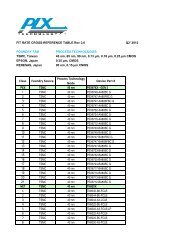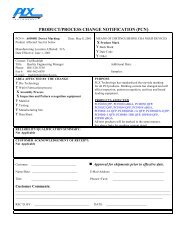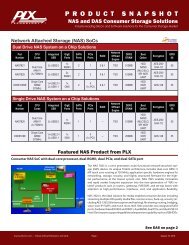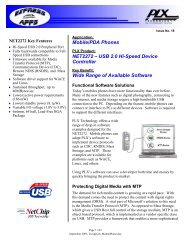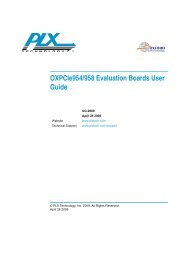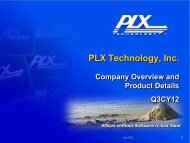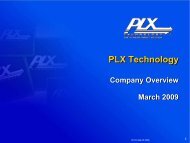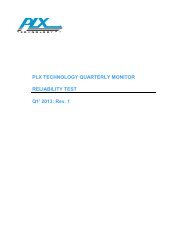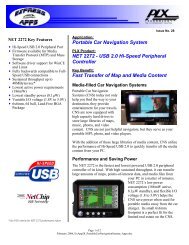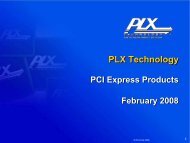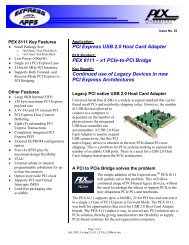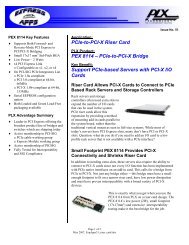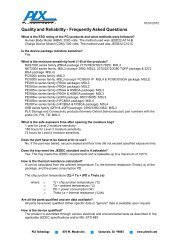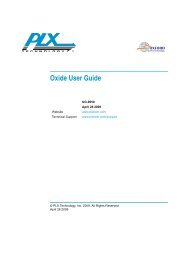the 2009 Annual Report (pdf) - PLX Technology
the 2009 Annual Report (pdf) - PLX Technology
the 2009 Annual Report (pdf) - PLX Technology
Create successful ePaper yourself
Turn your PDF publications into a flip-book with our unique Google optimized e-Paper software.
The Company analyzes <strong>the</strong> need for reserves for potential credit losses and records reserves when necessary.<br />
Through fiscal <strong>2009</strong>, <strong>the</strong>re were no direct end customers that accounted for more than 10% of net revenues. Sales to<br />
<strong>the</strong> following distributors accounted for 10% or more of net revenues:<br />
Years Ended December 31,<br />
<strong>2009</strong> 2008 2007<br />
Excelpoint Systems Pte Ltd…………………………… 25% 29% 18%<br />
Promate Electronics Co., Ltd………………………… 15% - *%<br />
Answer <strong>Technology</strong>, Inc.……………………………… 12% 13% 10%<br />
Avnet, Inc.…………………………………………… 12% 12% *%<br />
Metatech.……………………………………………… - - 17%<br />
∗ Less than 10%<br />
Currently, <strong>the</strong> Company relies on single source suppliers for <strong>the</strong> significant majority of its product inventory. As a<br />
result, should <strong>the</strong> Company's current suppliers not produce and deliver inventory for <strong>the</strong> Company to sell on a timely<br />
basis, operating results may be adversely impacted.<br />
6. Asset Impairment Charges<br />
During <strong>the</strong> fourth quarter of 2008, <strong>the</strong> Company assessed goodwill and long lived assets for impairment as it<br />
observed that <strong>the</strong>re were indicators of impairment. The notable indicators were a sustained decline in <strong>the</strong> Company’s<br />
market capitalization below book value, depressed market conditions, deteriorating industry trends and a significant<br />
downward revision of its forecasts. These market conditions continuously change and it is difficult to project how<br />
long an economic downturn may last. The Company’s goodwill and intangible assets were primarily established in<br />
purchase accounting at <strong>the</strong> completion of <strong>the</strong> Sebring, HiNT Corporation and NetChip <strong>Technology</strong>, Inc acquisitions<br />
in 2000, 2003 and 2004, respectively.<br />
The projected discounted cash flows for <strong>the</strong> Company’s single reporting unit were based on discrete five-year<br />
financial forecasts developed by management for planning purposes. Cash flows beyond <strong>the</strong> discrete forecasts were<br />
estimated using terminal value calculations. The terminal value represents <strong>the</strong> value of <strong>the</strong> Company’s single<br />
reporting unit at <strong>the</strong> end of <strong>the</strong> discrete forecast period. These forecasts represent <strong>the</strong> best estimate that management<br />
had at <strong>the</strong> time and were believed to be reasonable. The annual sales growth rates ranged from 5% to 7% during <strong>the</strong><br />
discrete forecast period and <strong>the</strong> future cash flows and terminal value were discounted to present value using a<br />
discount rate of 22%. The terminal value was based on <strong>the</strong> application of an 8.0x multiple to forecasted 2013 earnings<br />
before interest, taxes, depreciation and amortization expense (EBITDA). The discount rate was based on an analysis<br />
of <strong>the</strong> weighted average cost of capital of our single reporting unit. The EBITDA multiple used in <strong>the</strong> terminal value<br />
calculation was based upon EBITDA multiples paid in comparative merger and acquisition transactions and a review<br />
of trading multiples for similar public companies and considered <strong>the</strong> growth prospects and profitability for our single<br />
reporting unit at <strong>the</strong> end of <strong>the</strong> discrete forecast period.<br />
Prior to <strong>the</strong> Company’s goodwill impairment testing, it also assessed <strong>the</strong> fair value of its long-lived assets,<br />
including its corporate headquarters building and amortizable intangible assets. For <strong>the</strong> corporate headquarters<br />
building, <strong>the</strong> Company used <strong>the</strong> sales comparison approach and <strong>the</strong> income capitalization approach, each equally<br />
weighted, to arrive at a fair value estimate. The Company determined that <strong>the</strong> carrying value of <strong>the</strong> property was not<br />
recoverable and exceeded its fair value, and it recorded an impairment charge of $18.8 million. For <strong>the</strong> amortizable<br />
intangible assets, which included acquired technology, <strong>the</strong> Company estimated a negligible fair value using a relief<br />
from royalty method and recorded an impairment charge of $0.8 million related to all of <strong>the</strong> remaining net book value<br />
of this acquired technology.<br />
As part of <strong>the</strong> goodwill impairment test for <strong>the</strong> fourth quarter of 2008, <strong>the</strong> Company determined that step two of<br />
<strong>the</strong> impairment analysis was required because <strong>the</strong> estimated carrying value of its net assets, subsequent to <strong>the</strong><br />
impairment of long-lived assets noted above, exceeded its estimated fair value. The second step of <strong>the</strong> goodwill<br />
impairment test compared <strong>the</strong> implied fair value of <strong>the</strong> goodwill with <strong>the</strong> carrying amount of that goodwill. When <strong>the</strong><br />
carrying amount of <strong>the</strong> goodwill exceeds <strong>the</strong> implied fair value of that goodwill, an impairment loss is recognized in<br />
55




